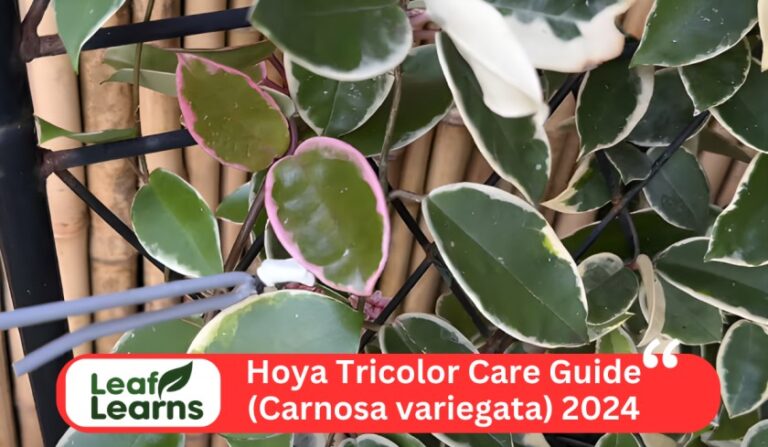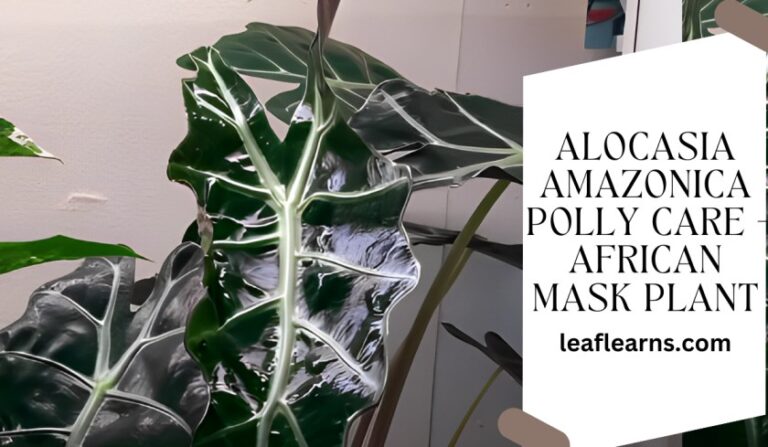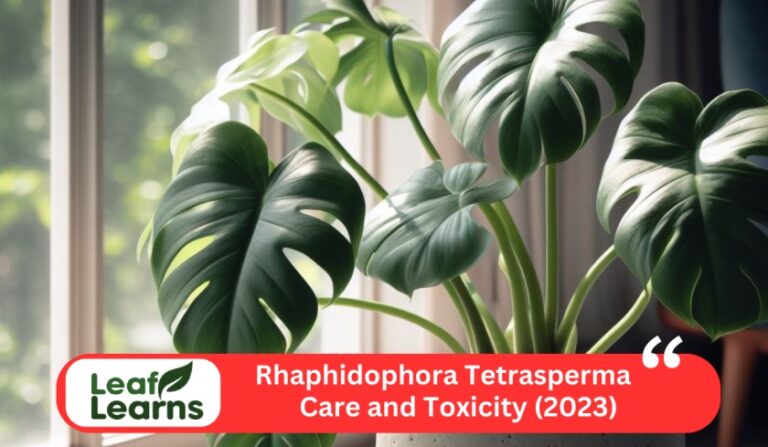Ming Fern Care (Asparagus retrofractus) – Leaflearns (2024)
Asparagus retrofractus is a beautiful ornamental plant that will make your home look sophisticated and spacey If you can do Ming Fern Care. From South Africa, there is an indigenous plant that is characterized by strange needles leaves which group together to come up with a soft looking green pom-poms.

Distinctive Foliage: Ming Ferns are not real ferns, but rather have thin, feathered “fronds” taking the form of numerous pin-shaped leaves. This brings additional charm to any locality, it implies the creation of textural contrast.
Low Maintenance: Suitable for beginners or overworked plant parents, the watering requirement is low and it grows best in a medium having good drainage. It is also a best air purifier.
| Common Name | Ming Fern |
|---|---|
| Scientific Name | Asparagus retrofractus |
| Family | Asparagaceae |
| Origin | South Africa |
| Plant Type | Perennial herbaceous plant |
| Size | 2-3 feet tall |
| Lifespan | Long-lived |
| Light | Bright, indirect light |
| Water | Moderate, keep soil evenly moist |
| Soil | Well-draining, fertile soil |
| Temperature | Warm, ideally between 65-80°F (18-27°C) |
| Humidity | Moderate to high |
| USDA Zone | 9-11 |
| Fertilizer | Balanced liquid fertilizer, monthly |
| Propagation | Division of clumps, seeds |
| Pruning | Regular pruning to maintain shape |
| Pests | Occasionally susceptible to aphids |
| Toxicity | Non-toxic |
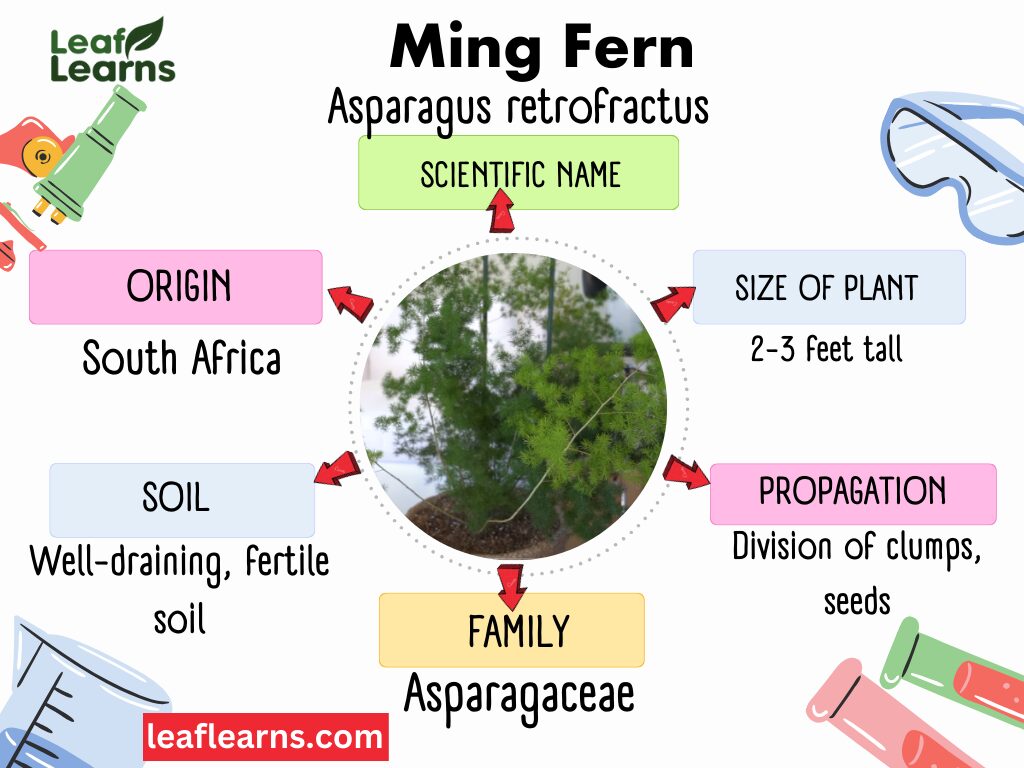
Contents
- 1 Ming fern Care
- 2 How to Propagate Ming Fern
- 3 Pruning Your Ming Fern
- 4 Repotting Your Ming Fern
- 5 Common Pests and Diseases
- 6 Toxicity of Ming Fern
- 7 Mastering Ming Fern Care: A Global Pursuit
- 8 Embracing the Majesty of Tree Ferns: Cultivating Botanical Wonders Across Continents
- 9 FAQs
- 9.1 How do you take care of a Ming Fern?
- 9.2 How much sun does a Ming fern need?
- 9.3 Why is my Ming fern turning yellow?
- 9.4 Do Ming ferns bloom?
- 9.5 How long does Ming fern last?
- 9.6 Do Ming ferns like sun or shade?
- 9.7 Should you water ferns every day?
- 9.8 How much water does a Ming fern need?
- 9.9 Is Ming Fern suitable for both indoor and outdoor use?
Ming fern Care
Light Requirement
Like a fine cup of tea, Ming Ferns, with their flowing greens, love bright, indirect sunshine! Here’s how to modify their light treatment all year long:
Summer: Picture yourself relaxing on a shaded porch swing; strive for soft sunshine or a short distance from an east-facing window. Those fragile leaves might go fried in the direct sunlight!
Winter: Brighter spot is required because of shorter days. Grow lights or windows facing south (sheer curtains are advised) end up becoming their greatest buddies.
Fall and spring are the ideal shoulder seasons! Keep them near windows so you can take advantage of the shifting natural light.
Water Requirements
In the Ming Fern Care like steady wetness, but not a swamp that is too wet! It’s important to comprehend their seasonal rhythm in order to properly water them. Get ready for a crash course on keeping your feathered buddy hydrated all year long, plant parents!
In the spring and summer,When the top inch of soil seems dry, water deeply as the days become longer and the temperature rises.
Fall & Winter: Envision taking a warm snooze by the hearth. As growth stops and the air cools, waterless regularly. Before offering them a drink, allow the top 2 inches of soil to dry. Steer clear of overwatering, since this might cause root rot.
Soil Requirement
For the Ming Fern care to thrive, it is essential to maintain ideal soil conditions. It grows best on rich, well-draining soil that strikes the ideal balance between moisture retention and aeration.
Summer: Don’t let it get too wet. When the top inch of soil is dry, water it. Extra credit for sprinkling the fluffy leaves on hot days.
Winter: As growth slows, reduce watering. To prevent root rot, allow the soil to dry out more in between waterings.
Autumn and spring are growth surge seasons! To keep the soil uniformly wet but not soggy, water it frequently.
Temperature Requirement
In the Ming Fern Care have a preferred temperature range, much like people do. The secret to joyful, healthy growth is understanding what makes children comfortable all year round.
In spring and autumn, the ideal temperature range is 65–75°F (18–24°C), with a small drop at night. This simulates the climate of South Africa naturally.
Summertime: Remain chilled! Provide plenty of indirect sunlight when the temperature rises, and spray often to boost humidity. Don’t go beyond 85°F (29°C).
Winter: Avoid letting the cold get to you! Maintain temperatures above 55°F (13°C) and cover your fern from drafts and chilly windows.
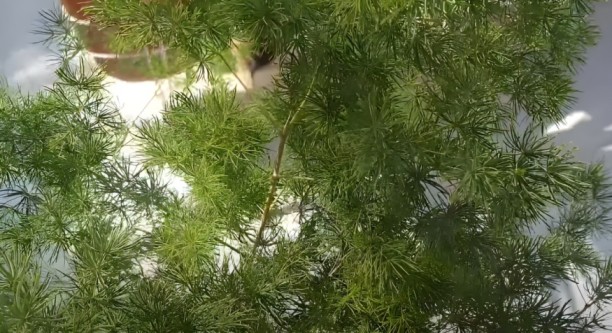
Humidity Requirement
Ming ferns like a humidity level of between 50% and 70%, although they may tolerate up to 100%. Nevertheless, based on the season, their requirements may change slightly:
Summer: Try to achieve humidity levels that are closer to 70% during the sweltering summer months. To do this, put your Ming Fern in a group with other plants that thrive in humidity, use a pebble tray, or keep a humidifier running close by.
Winter: You may use a humidifier or often spritz your Ming Fern to keep humidity levels around 50% throughout the winter when indoor air tends to be drier.
Spring and Autumn: Keep humidity levels between 50% and 60% throughout these seasons of transition.
Fertilizer Requirement
During the spring and summer growing seasons, give the Ming Fern a monthly dose of a balanced liquid fertilizer to ensure its continued growth.
Ming Fern Care don’t need a lot of food, but a little bit will go a long way. The lowdown is as follows:
Summer and springtime are a feast! During active growth, feed once a month with a balanced liquid fertilizer that has been diluted to half-strength.
Fall: Take it easy! As development slows, cut down on feeding to once every 6 to 8 weeks.
Winter: It’s hibernation time! Give your fern no fertilizer at all, allowing it to rest and save energy.
Potting Requirement
When it comes to potting, Ming Fern Care are quite simple to maintain. Here is a brief how-to:
Pot: To avoid root rot, use a pot with drainage holes. The pot has to be just a little bit bigger than your Ming Fern’s root ball.
Soil: Use a potting mix that drains properly. Compost, perlite, and peat moss make up a nice mixture. If you want to grow ferns or African violets, you may also use a professional potting mix.
Watering: When the top inch of soil becomes dry, water your Ming Fern. You could require more frequent watering during the summer. You may water less often throughout the winter.
Fertilizing: During the spring and summer growing seasons, fertilize your Ming Fern once a month with a balanced liquid fertilizer.
Summer: Ming Ferns like it humid throughout the summer. The plant may be made more humid by spraying it frequently or by setting it on a pebble tray that has water in it.
Winter: Ming Ferns like it when it’s colder outside. Keep them away from heat sources and drafts.
If necessary, you should repot your Ming Fern in the spring or autumn.
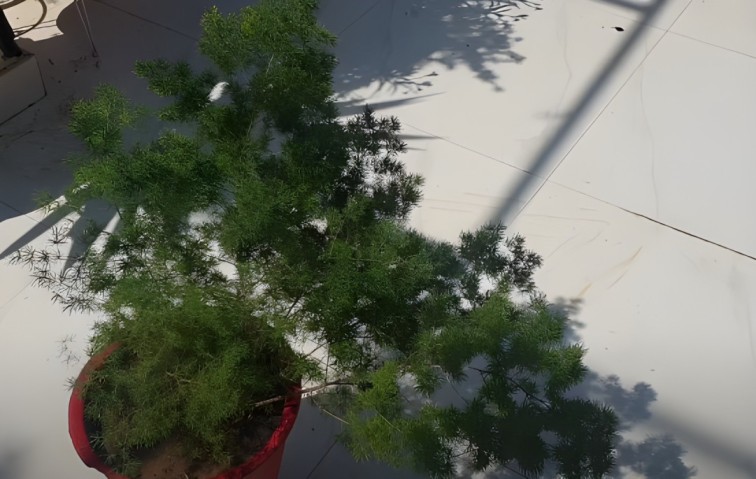
How to Propagate Ming Fern
Growing Ming Ferns is a rather simple process. A typical approach is to divide apart pre-existing clumps.
Separate the rhizomes or root clusters with caution, making sure that the roots and leaves of each division are sound. Plant the divisions in soil that drains well, and water them consistently until roots form.
Propagation from seeds is another technique, but one that could provide results more gradually. Plant seeds in potting mix, cover sparingly and keep the environment consistently warm and wet.
Pruning Your Ming Fern
Pruning strategically is necessary to keep the lovely form of your Ming Fern intact and to promote new growth. Here is a brief how-to:
The best time to plant is in the early spring when it is actively growing.
Tools: Sterilised scissors or pruning shears that are sharp.
Method: To promote bushier growth, remove any brown or yellowing fronds and trim good stems back to the desired length.
Repotting Your Ming Fern
Your Ming Fern Care may require a larger container as it gets larger to fit its spreading root system. This is when and how to pot again:
When the plant is actively growing, which occurs in the spring or early summer.
Pick a pot with drainage holes that are 1-2 inches broader than the one you already have.
Soil: Use a potting mix that drains well and has a hint of acidity.
Method: Loosen the root ball gently, cut off any dead roots, and then transplant it into the new pot, adding dirt on top.
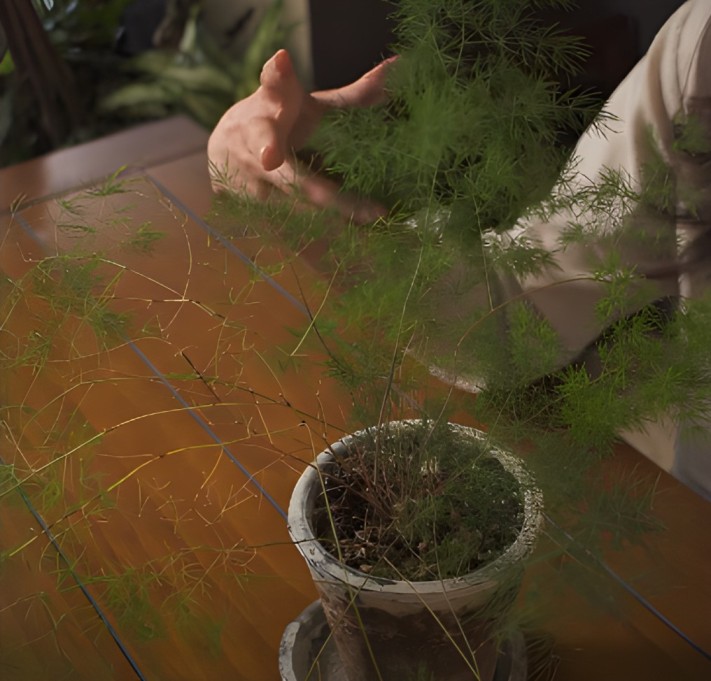
Common Pests and Diseases
Ming Ferns are generally low-maintenance plants, however they can host unwanted visitors. Watch out for these frequent dangers:
Invaders with pests
Spider mites: Tiny arachnids that cause delicate webbing and withering of the leaves.
Mealybugs: Cottony masses that cause wilting and sticky residue by sucking plant sap.
Scale insects: Tiny lumps that deplete nutrients and damage plants on leaves or stems.
Diseaase
Root rot: Soggy soil from over watering suffocates roots and causes leaves to turn yellow.
Bacterial wilt: When plants are damaged or there is insufficient air circulation, leaves wilt and turn brown.
Fungal diseases: Brown or black spots on leaves, caused by excessive moisture or humidity.
Toxicity of Ming Fern
Ming Fern (Asparagus retrofractus) is non-toxic to humans, cats, and dogs but caution is necessary, especially for pet owners. While not deadly, it contains toxins that can cause discomfort:
For Humans
- Mild Skin Irritation: Sensitive people may experience itching or redness upon direct contact with sap.
- Unset Stomach: Although rare owing to the harsh flavor of the plant, ingestion may cause nausea, vomiting, or diarrhea.
- For Dogs & Cats
- Gastrointestinal Upset: Eating any component of the plant can induce vomiting, diarrhea, and discomfort in the abdomen, much like it does in people.
- Dermatitis: Skin irritation and rashes can be brought on by frequent contact with leaves or sap.
Mastering Ming Fern Care: A Global Pursuit
In the realm of indoor plant enthusiasts, the quest for nurturing the delicate Ming Fern stands as both a challenge and a joy.
From meticulously crafted care guides to personal anecdotes shared on video platforms, Ming Fern aficionados exchange tips and experiences in their pursuit of mastering the art of Ming Fern care.
Whether it’s deciphering the nuances of light and humidity or exploring innovative techniques like using quartz crystals for enhanced growth, the community leaves no stone unturned in ensuring the well-being of their verdant companions.
Ming Fern care transcends borders, with enthusiasts from diverse linguistic backgrounds coming together to share their insights, be it in Deutsch, Japanese, or any other tongue.
Embracing the Majesty of Tree Ferns: Cultivating Botanical Wonders Across Continents
Meanwhile, in the botanical realm, the majestic Tree Fern reigns supreme, captivating the hearts of gardeners and landscapers with its striking presence and unique growth patterns.
From the frosty winters of the UK to the sunny landscapes of Australia, tree fern caretakers navigate the intricacies of seasonal variations and specific care requirements with unwavering dedication.
As discussions ensue about growth rates and optimal planting techniques, tree fern enthusiasts exchange anecdotes about sourcing the perfect specimen, from quaint pots to grand slabs, ensuring that each addition to their collection contributes to the enchanting tapestry of their botanical haven.
FAQs
How do you take care of a Ming Fern?
Ming ferns require little care and thrive with minimal attention. Plant them in well-draining soil and water them often enough to keep the soil damp but not muddy.
They do well indoors or in areas with partial shade outside since they like indirect sunlight or some shade. Regular trimming will keep them looking good.
How much sun does a Ming fern need?
Ming ferns prefer indirect sunlight or partial shade. Avoid direct sun, which can scorch the leaves.
Why is my Ming fern turning yellow?
Yellowing leaves can be caused by a number of factors, including direct sunshine, nutritional deficiencies, overwatering, underwatering, and low humidity. Watch how you water, and make any necessary adjustments.
Do Ming ferns bloom?
Yes, but rarely indoors. They produce small, greenish-white flowers, but they are not very showy.
How long does Ming fern last?
With proper care, Ming ferns can live for many years, even decades!
Do Ming ferns like sun or shade?
Shade! They prefer indirect sunlight or partial shade.
Should you water ferns every day?
Not at all! Overwatering is a frequent problem. When the top inch of soil seems dry, water it.
How much water does a Ming fern need?
The quantity is determined by elements such as climate, light, and pot size. To keep the soil equally wet but not drenched, water it often.
Is Ming Fern suitable for both indoor and outdoor use?
Indeed! They grow well outside in regions with some shade and indoors in indirect sunshine. Simply move them inside when it gets colder than 50°F (10°C).

